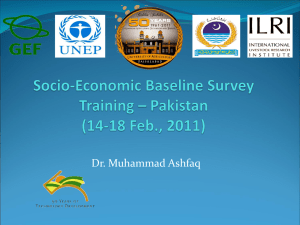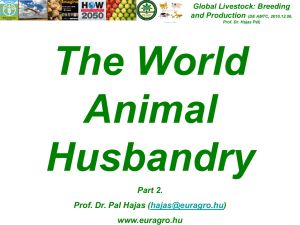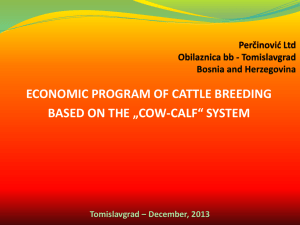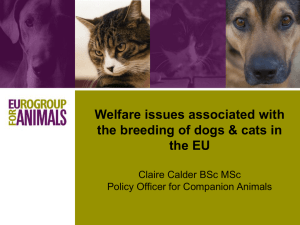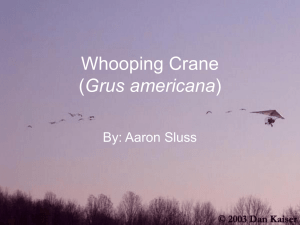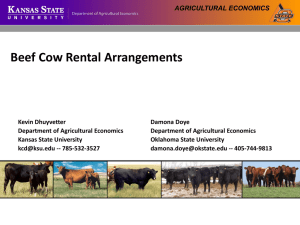1. dia
advertisement
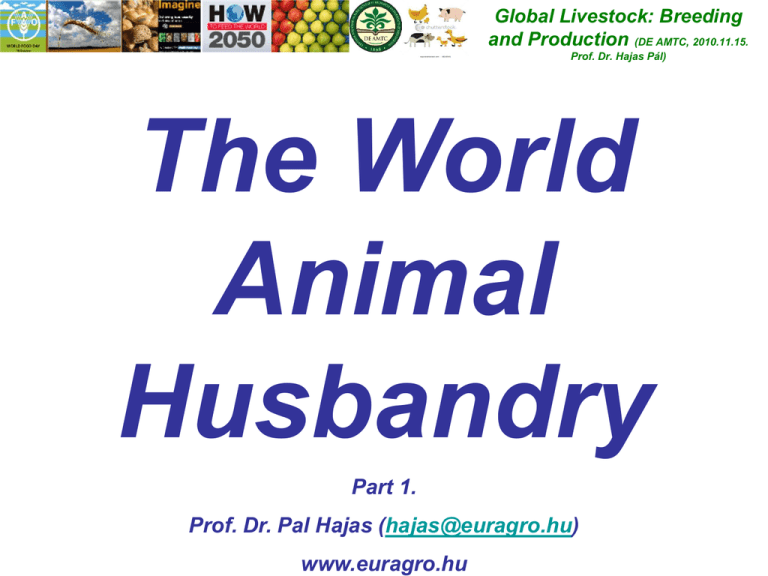
Global Livestock: Breeding and Production (DE AMTC, 2010.11.15. Prof. Dr. Hajas Pál) The World Animal Husbandry Part 1. Prof. Dr. Pal Hajas (hajas@euragro.hu) www.euragro.hu Global Livestock: Breeding and Production (DE AMTC, 2010.11.15. Prof. Dr. Hajas Pál) World Animal Husbandry Global Livestock Breeding Global Livestock: Breeding and Production (DE AMTC, 2010.11.15. Prof. Dr. Hajas Pál) World Animal Husbandry Global Livestock Breeding Management of Animal Genetic Resources Global Livestock: Breeding and Production (DE AMTC, 2010.11.15. Prof. Dr. Hajas Pál) World Animal Husbandry Global Livestock Breeding Management of Animal Genetic Resources Animal Production Systems Global Livestock: Breeding and Production (DE AMTC, 2010.11.15. Prof. Dr. Hajas Pál) World Animal Husbandry Global Livestock Breeding Management of Animal Genetic Resources Animal Production Systems Animal Welfare Global Livestock: Breeding and Production (DE AMTC, 2010.11.15. Prof. Dr. Hajas Pál) World Animal Husbandry Global Livestock Breeding Management of Animal Genetic Resources Animal Production Systems Animal Welfare Meat, Milk, Eggs, Wool, Hides, etc. Global Livestock: Breeding and Production (DE AMTC, 2010.11.15. Prof. Dr. Hajas Pál) What is „Animal Production?” Global Livestock: Breeding and Production (DE AMTC, 2010.11.15. Prof. Dr. Hajas Pál) Global Livestock: Breeding and Production (DE AMTC, 2010.11.15. Prof. Dr. Hajas Pál) What is the view of the UN and FAO? Trends in world hunger FAO, Rome, September 2009 Global Livestock: Breeding and Production (DE AMTC, 2010.11.15. Prof. Dr. Hajas Pál) Look into the Future Population growth FAO, Rome, September 2009 Global Livestock: Breeding and Production (DE AMTC, 2010.11.15. Prof. Dr. Hajas Pál) The Future of Animal Production 1. Need for urgent action, as the wise management of the world’s animal genetic resources will be of even greater importance in the future 2. The world’s population expected to increase in the next forty years from 6.2 billion to 9 billion people. 3. More people will require more meat, milk, eggs and other livestock products 4. A wide portfolio of animal genetic resources will be crucial in adapting and developing the world’s agricultural production systems 5. Increasing the resilience of our food supply. Global Livestock: Breeding and Production (DE AMTC, 2010.11.15. Prof. Dr. Hajas Pál) The Future of Animal Production Nearly all of this population increase will occur in developing countries. Urbanization will continue at an accelerated pace About 70 percent of the world’s population will be urban (compared to 49 percent today). Income levels will be many multiples of what they are now. In order to feed this larger, more urban and richer population, food production (net of food used for biofuels) must increase by 70 percent. Annual cereal production will need to rise to about 3 billion tonnes from 2.1 billion today Annual meat production will need to rise by over 200 million tonnes to reach 470 million tonnes. Global Livestock: Breeding and Production (DE AMTC, 2010.11.15. Prof. Dr. Hajas Pál) The Future of Animal Production • Total average annual net investment in developing country agriculture required to deliver the necessary production increases would amount to USD 83 billion. • The global gap in what is required vis-à-vis current investment levels can be illustrated by comparing the required annual gross investment of US$209 billion (which includes the cost of renewing depreciating investments) with the result of a separate study that estimated that developing countries on average invested USD 142 billion (USD of 2009) annually in agriculture over the past decade. Global Livestock: Breeding and Production (DE AMTC, 2010.11.15. Prof. Dr. Hajas Pál) The Future of Animal Production • The required increase is thus about 50 percent. These figures are totals for public and private investment, i.e. investments by farmers. Achieving them will require a major reallocation in • developing country budgets as well as in donor programmes. • It will also require policies that support farmers in developing countries and encourage them and other private participants in agriculture to Global Livestock: Breeding and Production (DE AMTC, 2010.11.15. Prof. Dr. Hajas Pál) http://www.fao.org/fileadmin/templates /wsfs/docs/expert_paper/How_to_Feed _the_World_in_2050.pdf Page 5. 6. 9. 12. Global Livestock: Breeding and Production (DE AMTC, 2010.11.15. Prof. Dr. Hajas Pál) Meat consumption per caput for example would rise from 41 kg at present to 52 kg in 2050 (from 30 to 44 kg in the developing countries). Global Livestock: Breeding and Production (DE AMTC, 2010.11.15. Prof. Dr. Hajas Pál) What is „Animal Production?” Do we need to produce meat in Animal Factory ? http://www.youtube.com/watch?v=QsmAq_4uQH4 Global Livestock: Breeding and Production (DE AMTC, 2010.11.15. Prof. Dr. Hajas Pál) What is „Animal Production?” Or Do we sense When pigs cry? http://www.youtube.com/watch?v=GA6UyPOtZxc&featur e=BF&list=PLD91AEE0A87BAFB57&index=17 Global Livestock: Breeding and Production (DE AMTC, 2010.11.15. Prof. Dr. Hajas Pál) What kind of Forums available to interact for „Animal Production?” Global Livestock: Breeding and Production (DE AMTC, 2010.11.15. Prof. Dr. Hajas Pál) FAO Rome 6th Session of the Intergovernmental Technical Working Group on Animal Genetic Resources for Food and Agriculture (2010) http://www.fao.org/ag/againfo/programmes/en/genetics/angrvent2010.html http://dad.fao.org/ Intergovernmental Technical Working Group on Animal Genetic Resources, Sixth Session, Rome, 24–26, November 2010 The Sixth Session of the Intergovernmental Technical Working Group on Animal Genetic Resources for Food and Agriculture will be held at FAO Headquarters in Rome from 24-26 November 2010. The Working Group was established by the Commission on Genetic Resources for Food and Agriculture at its Seventh Session in May 1997 Global Livestock: Breeding and Production (DE AMTC, 2010.11.15. Prof. Dr. Hajas Pál) FAO Rome Regular Session of the Commission to review: •progress made and action taken to implement the Global Plan of Action, including the Funding Strategy; •status and trends reporting; •country-based early warning and response systems, including technical indicators; and •the further development of technical guidelines and DAD-IS. Global Livestock: Breeding and Production (DE AMTC, 2010.11.15. Prof. Dr. Hajas Pál) ITWG: The members of the Working Group, as elected by the Twelfth Session of the Commission, are as follows: Africa: Cameroon, Ethiopia, Morocco, South Africa, Togo Asia: China, Mongolia, Nepal, Republic of Korea, Thailand Europe: Finland, Germany, Netherlands, Switzerland, Turkey Latin America and the Caribbean: Brazil, Chile, Costa Rica, Jamaica, Venezuela (Bolivarian Republic of) Near East: Islamic Republic of Iran, Jordan, Qatar North America: Canada, United States of America Southwest Pacific: Papua New Guinea, Samoa Members of the Commission which are not members of the Working Group may participate, upon request to the Commission Secretariat, in the work of the Working Group in an observer capacity. Global Livestock: Breeding and Production (DE AMTC, 2010.11.15. Prof. Dr. Hajas Pál) Opportunities in Animal Breeding and Production: Biological Diversity – Agricultural-Bio Diversity Animal Genetic Resources Breeding systems Production technologies Global Livestock: Breeding and Production (DE AMTC, 2010.11.15. Prof. Dr. Hajas Pál) Iceland: The Leader Sheep A separate breeding line, Leader-sheep, was identified within population of Icelandic sheep. These sheep have long been known for their special leadership characteristics, an unusual ability to find their way and great intelligence. Cross-breeding of leader-sheep and other sheep clearly shows that these traits seem to be completely dependent on heredity. The total number of Leader-sheep in Iceland is slightly over one thousand. There are no comparable sheep anywhere else in the world. Source: Country Report Iceland. 2003. Country report on the state of animal genetic resources. (available in DAD-IS library at http://www.fao.org/dad-is/). Global Livestock: Breeding and Production (DE AMTC, 2010.11.15. Prof. Dr. Hajas Pál) Hungary: The Grey Cattle The genetic origin of Hungarian Grey cattle has not been definitively elucidated. Ancestral animals may have come from Asia or from Mediterranean areas, and a genetic contribution from the wild aurochs has been suggested. The character of the breed developed slowly under the husbandry of the Hungarian breeders of the Carpathian Basin. Between the fourteenth and seventeenth centuries cattle were exported on a large scale, with herds covering several hundred kilometres on foot to Nürnberg, Strasburg or Venice. Global Livestock: Breeding and Production (DE AMTC, 2010.11.15. Prof. Dr. Hajas Pál) Hungary: The Grey Cattle Demand emerged for a “trade-mark” appearance which guaranteed the quality of Hungarian beef. The long-horn animals with handsome conformation, hardy, healthy character, and excellent meat quality were greatly valued by contemporary buyers. The early eighteenth century began a new period in the breed’s history, as urban populations expanded and required supplies of agricultural products. Since the demand was mainly for cereals, extensive animal husbandry declined. During this period, the function of the breed shifted to the production of working oxen. Czech sugar factories valued them for their fast movement, their simple dietary requirements, and their exceptional longevity. With the introduction of tractors after the First World War many farms disposed of their Hungarian Greys. Global Livestock: Breeding and Production (DE AMTC, 2010.11.15. Prof. Dr. Hajas Pál) Hungary: The Grey Cattle In 1931, the Hungarian Grey Cattle Breeders’ National Association was founded and breeding activity was stimulated. However the Second World War severely disrupted these endeavours and many herds were destroyed. By the early 1960s the only remaining herds were found on three state farms, with a total stock of six bulls and about 160 cows. Because of a certain patriotic attachment to the breed, and the provision of small but permanent subsidies by the state, the population started to increase. Today, functions of the breed include conservation grazing in National Parks, hobby breeding and a role as a tourist attraction. With respect to meat production, the breeders and the Hungarian Grey Cattle Breeders’ Association aim to organize meat processing and develop high-value products such as speciality sausages." Global Livestock: Breeding and Production (DE AMTC, 2010.11.15. Prof. Dr. Hajas Pál) Somba cattle Small, hardy, trypanotolerant taurins which are traditionally reared in a mixed farming system. Pure somba are important in traditional ceremonies. The number of purebred Somba is falling sharply. Their conservation is desirable since they suit the production system, disease challenge and climate; they have original genetic characteristics for trypanotolerance. Source: FAO. 2007. Tamberma’s Somba cattle breed at risk of extinction in Togo, by Bonfoh Bèdibètè, Adoméfa Kossi & Bassowa Habrè. In K-A. Tempelman & R.A. Cardellino eds. People and animals. Traditional livestock keepers: guardians of domestic animal diversity, pp. 79–83. FAO Interdepartmental Working Group on Biological Diversity for Food and Agriculture. Rome. Global Livestock: Breeding and Production (DE AMTC, 2010.11.15. Prof. Dr. Hajas Pál) Neuqu’n criollo goats The breed is the main source of income and animal protein for many households in the north of Neuqu’n province in Argentine Patagonia. The goats are well adapted to the transhumant movements which have traditionally shaped the lives of the goat keepers or crianceros. Global Livestock: Breeding and Production (DE AMTC, 2010.11.15. Prof. Dr. Hajas Pál) The Enderby Island cattle, New Zealand It shows that the breeding process is complicated and requires a lot of time and resources. Enderby is a small island situated 320 kilometres to the south of New Zealand. Cattle were first brought to the island in 1894 After 100 years surviving Enderby’s harsh climate and a diet of scrub and seaweed, the cattle were hardy, small, stocky and well adapted. In 1991, to preserve the local wildlife, the Enderby cattle were shot. Sperm and oocytes from the dead animals were collected for cryoconservation, but attempts to fertilize the oocytes failed and it appeared that the Enderby breed had been wiped out forever. The following year, members of the New Zealand Rare Breeds Conservation Society (NZRBCS), discovered a cow and a calf on the island. Global Livestock: Breeding and Production (DE AMTC, 2010.11.15. Prof. Dr. Hajas Pál) The Enderby Island cattle, New Zealand The animals were captured by helicopter and shipped to New Zealand. The subsequent death of the calf meant that „Lady”, as the cow became known, was the last of the Enderby cattle. Attempts to produce a calf, through artificial insemination and MOET, using the cryoconserved semen taken from the bulls killed on the island, did not prove successful. Again it appeared that the breed faced extinction. However, in 1997 NZRBCS in collaboration with AgResearch successfully produced a calf, Elsie, cloned from a sample of Lady’s somatic cells. Four more cloned heifers were born the following year. Meanwhile, efforts to produce an Enderby bull through in vitro fertilization using the cryoconserved semen and oocytes taken from Lady had also proved successful, with the birth of „Derby”. Two of the clones later died, but in 2002 two more Enderby calves were born through natural mating of the cloned heifers and Derby." Global Livestock: Breeding and Production (DE AMTC, 2010.11.15. Prof. Dr. Hajas Pál) The Kari sheep, Pakistan A small-seized sheep breed has recently been characterized along with documentation of the socio-economic conditions of the keepers who have been breeding and raising this genetic resource for sustenance in the harsh cold climate at North Chitral, Pakistan. This area, close to the mountainous regions, becomes isolated in winter due to closure of the only route that links it with the rest of Pakistan to the south. Women take care of the livestock not only by grazing the flocks on high pastures during summer, but also in winter when most of the men leave the area to seek jobs. Global Livestock: Breeding and Production (DE AMTC, 2010.11.15. Prof. Dr. Hajas Pál) The Kari sheep, Pakistan The transhumant grazing system is characterized by long-standing customary usage of the available feed resources through a seasonal migration pattern. This usage has probably helped in sustaining the ecological balance within the system. The Kari sheep is an indispensable breed contributing to the socioeconomic status of the local people. Its white, brown and black coloured wool is used to produce a handmade woollen cloth (Patti). Walnut husk is also used to colour the white wool to other shades of brown. This 23 micron diameter wool, finer than any of the 25 sheep breeds found in the country, is used to make the typical headgear and warm waistcoats worn not only in the local area, but also in other parts of the province and the country. A major threat to the purity of this 16 kg sheep breed is posed by migrating flocks from Afghanistan. Source: Dr. M. Sajjad Khan Department of Animal Breeding and Genetics, University of Agriculture Faisalabad 38040 Pakistan email: drsajjad2@yahoo.com Global Livestock: Breeding and Production (DE AMTC, 2010.11.15. Prof. Dr. Hajas Pál) Sri Lankan Chicken The family poultry sector (FPS) or the backyard poultry sector has an important place in the Sri Lankan rural economy. The contribution by this sector was about 30 percent of total egg and meat produced during the mid 1980s, but this contribution fell to 15 percent in 1993 and to 5 percent by 2005. There has been a rapid decline in the indigenous chicken population during this period. Backyard poultry production is predominantly an egg production system. The indigenous birds also have genetic potential for meat production; surplus cockerels and spent hens are a good source of meat in rural areas. Global Livestock: Breeding and Production (DE AMTC, 2010.11.15. Prof. Dr. Hajas Pál) Mangalica Pig, Hungary Pig breeding is the most important branch of livestock breeding. The old type of lard pigs has been almost completely replaced, except for the Mangalitsa breed which has gained popularity and increased numbers because of the unsaturated fatty acids in its fat. Source: Country Report Hungary. 2003. Country report on the state of animal genetic resources. (available in DAD-IS library at http://www.fao.org/dad-is/). Global Livestock: Breeding and Production (DE AMTC, 2010.11.15. Prof. Dr. Hajas Pál) Nelore Cattle, Argentina The Nelore originates from Indian Zebu-type Ongole cattle. In Brazil the breed came to be known as Nelore, after the district of Nellore in Andhra Pradesh, India. The breed thrived in South America, and in the 1950s Argentina started its own breeding programme for the “Nelore Argentino”. In 1995, the breed made up more than 60 percent of Brazil’s 160 million cattle and in 2005 some 85 percent of Brazil’s 190 million cattle, had Nelore blood. Ironically, while the Ongole has been successfully established in a number of countries in North and South America, the Caribbean, Southeast Asia, and Australia, its population has greatly declined in its original range in coastal Andhra Pradesh, and it is qualitatively inferior to the Nelore population in Brazil. Global Livestock: Breeding and Production (DE AMTC, 2010.11.15. Prof. Dr. Hajas Pál) What is „Animal Production?” Grazing Plan: http://www.youtube.com/wat ch?v=hjWDsbCQUoY

